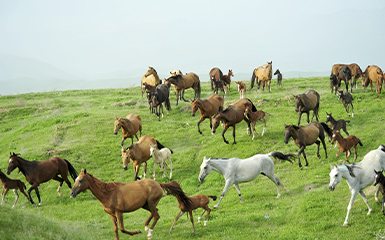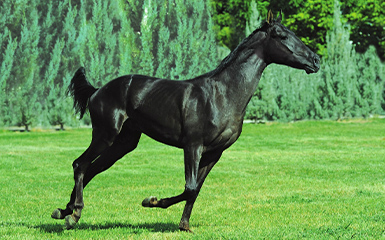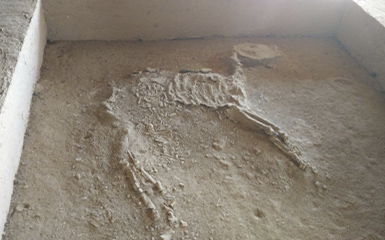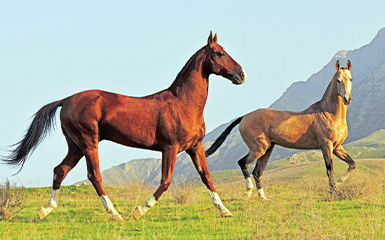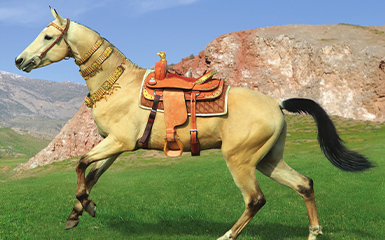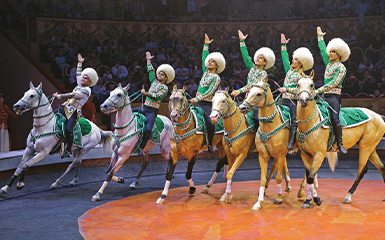Akhal-teke horse is a recognized ideal of beauty for true connoisseurs of horses from ancient times to nowadays. Its amazing beauty and gracefulness and at the same time strength and endurance evokes admiration.
The conformation of the Akhal-teke horse strikes with refinement and nobleness. It is tall, thin and wiry, with a narrow and relatively deep chest, high and well-defined withers, strong croup, and long skinny legs. The movements of the Akhal-teke horse, accustomed to loose sands, are flexible like those of a cat; its gallop is flat, as if gliding over the ground. Its neck is long, thin and flexible, having a peculiar ‘deer’ shape. The Akhal-teke horse has long, thin ears, a refined, graceful facial part of the head and very special eyes: large, expressive, with a characteristic elongated shape. The horse keeps a light noble head high. The colours of the Akhal-teke horse are varied and admirable: bay, black, red, grey, dun (all shades), cream-coloured, Isabella. However, even the usual colour of the Akhal-teke horse is often transformed, acquiring a bright golden shade, which has been characteristic of the ancestors of this breed from ancient times.
This is one of the oldest breeds in the world. Numerous historical and documentary facts unanimously indicate that the most ancient centres of cultural horse breeding are the oases in Central Asia, and, first, Turkmenistan. According to many experts, the horse was first domesticated by the distant ancestors of the Turkmen people on the territory of our country. The artefacts that were discovered at different times at the excavations of archaeological sites in Turkmenistan proved this fact.
The findings by the expedition headed by Professor Viktor Sarianidi were sensational. The remains of a cart with bronze rims, the stone statue of a horse with a clearly marked saddle, the trumpets for formation of the horse riders, and most important – the oldest burial of a sacrificial foal in Central Asia and the Middle East were discovered at the royal tombs in Gonur, the capital of the ancient country of Margush in the Murgab River delta. These findings evidence that the domesticated horse was a part of the life of inhabitants in the ancient country of Margush already in the late third – early second millennia BC!
The glory of the Turkmen horses, called by the ancient chroniclers ‘divine’, ‘heavenly’, ‘paradise’, ‘noble’, ‘supernatural’ horses, dates back to the first millennium BC. Alexander the Great and the Chinese emperors tried to capture and sent military expeditions for the Akhal-teke horses. The ancient writers called the ancestors of the present-day Akhal-teke horses the ‘Nisian’ horses, after the name of Nisa – a royal residence of the prosperous Parthia.
Early in the 20th century, the horses from the Ahal oasis were called Akhal-teke. The qualities of this unique breed have been improved on the edge of the Karakum Desert for centuries. The equestrian secrets have been passed down from generation to generation. The life of the Turkmen people depended on these excellent horses. Being a loyal friend, the horse withstood the hot sands, carried a soldier with weapons, a heavy felt mat and supplies, covering huge distances day after day. The Akhal-teke horse used to be the best friend, a member of the family. This attitude resulted in perfect selection and improvement of the breed on a regular basis.
The Akhal-teke horses never grazed in herds. The Turkmen people kept one or two horses at a time, hand-fed them selected grain, flat cakes with lamb fat, and carefully prepared for the races. The Akhal-teke horses endured hunger and thirst better than the other breeds. The foal was considered part of the family, was given every attention and love. That is why the Akhal-teke horses are notable for devotion to the owner and alertness to strangers. The life in a ‘family’ did not spoil the horses. On the contrary, experienced equestrians (in Turkmen ‘seyis’) helped the horses develop extraordinary endurance and speed. The breed has been improving for centuries.
Turkmen horse breeding continues the traditions of ancestors and attracts special attention of the world’s best specialists. The secret of the impressive skills of the Turkmen horse breeders is in the special, spiritual unity of a person and a horse, in a kind of telepathic contact beyond the understanding of amateurs, in treating a horse as a friend or a fellow. To date, the art of breeding the Akhal-teke horses, which represent the national treasure of the Turkmen people, claims to be inscribed on the UNESCO Intangible Cultural Heritage List.

